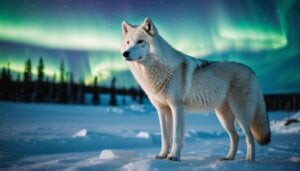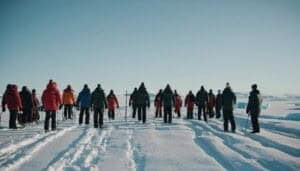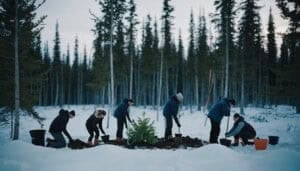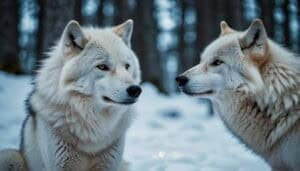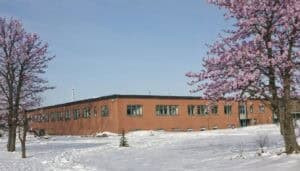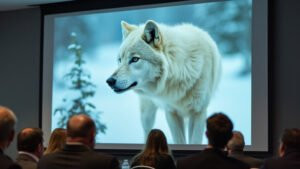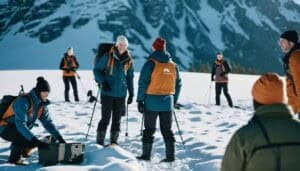Introduction
Arctic wolves are facing numerous threats due to climate change and human activities. Protecting these majestic animals requires collaborative efforts from both international organizations and local communities
This article explores the roles of major organizations such as the World Wildlife Fund (WWF), the Arctic Council, and the Conservation of Arctic Flora and Fauna (CAFF). We will also delve into how local communities contribute to these efforts, the challenges they face, and the successes achieved
By understanding these collaborative endeavors, we can better appreciate the efforts to preserve the Arctic wolves and their habitat
Role of the World Wildlife Fund in Protecting Arctic Wolves
The World Wildlife Fund (WWF) is one of the most prominent international organizations dedicated to the conservation of wildlife, including Arctic wolves
Through its various initiatives and partnerships, WWF plays a crucial role in ensuring the survival and protection of these animals in the face of environmental threats
WWF’s Arctic Programs
WWF’s Arctic programs are comprehensive, targeting multiple aspects of conservation in the region. The organization focuses on habitat protection, species conservation, and mitigating the effects of climate change
One key aspect of their work involves extensive research and monitoring of Arctic wildlife populations, including Arctic wolves. This research helps to understand the wolves’ behaviors, population dynamics, and the impacts of environmental changes on their survival
WWF also prioritizes the preservation of critical habitats for Arctic wolves. By identifying and protecting key areas where these wolves live and hunt, WWF ensures that the wolves have access to the resources they need to thrive
This habitat protection is often done in collaboration with local communities who provide valuable insights and assistance in maintaining these areas
Partnerships with Local Communities
WWF’s collaboration with local communities is a cornerstone of its conservation strategy. In the Arctic, these communities often include indigenous peoples who have lived in harmony with the environment for generations. Their traditional knowledge and practices are invaluable in creating effective conservation strategies
One of the main ways WWF partners with local communities is through co-management agreements
These agreements allow local communities to take an active role in the management and protection of natural resources, including Arctic wolves. This approach not only empowers the communities but also ensures that conservation efforts are culturally appropriate and sustainable
For example, in areas like the Canadian Arctic, WWF has worked with indigenous groups to develop community-based monitoring programs. These programs train local residents to monitor wolf populations and habitats, providing real-time data that is crucial for conservation planning. Such initiatives foster a sense of ownership and responsibility towards the wildlife, leading to more successful conservation outcomes
Conservation Successes
WWF’s efforts in protecting Arctic wolves have led to several notable successes. Through its research and advocacy, WWF has been able to secure protections for critical habitats that are essential for the survival of Arctic wolves
Additionally, their work with local communities has resulted in the creation of new conservation areas that benefit both the wolves and the people living in the region
One significant success story is the establishment of the Arctic National Wildlife Refuge in the United States. While this refuge was primarily created to protect a variety of Arctic wildlife, the inclusion of Arctic wolves as a key species has helped ensure that these predators have a safe and secure habitat
WWF’s advocacy and collaboration with other conservation groups were instrumental in achieving this milestone
Moreover, WWF’s efforts to address climate change are indirectly benefiting Arctic wolves. By advocating for policies that reduce greenhouse gas emissions and supporting renewable energy projects, WWF is working to mitigate the effects of climate change, which is one of the biggest threats to the Arctic ecosystem
Arctic Council’s Collaboration with Local Communities
The Arctic Council is an intergovernmental forum that addresses issues faced by Arctic governments and indigenous peoples of the Arctic. Formed in 1996, the Council plays a vital role in fostering cooperation and coordinating efforts to protect the Arctic environment, including the conservation of Arctic wolves
Structure and Objectives
The Arctic Council comprises eight Arctic states: Canada, Denmark, Finland, Iceland, Norway, Russia, Sweden, and the United States
Additionally, it includes six permanent participants representing Arctic indigenous peoples: the Aleut International Association, the Arctic Athabaskan Council, Gwich’in Council International, the Inuit Circumpolar Council, the Russian Association of Indigenous Peoples of the North, and the Saami Council
The Council’s objectives focus on promoting sustainable development and environmental protection in the Arctic. It facilitates collaboration on various issues, including biodiversity conservation, climate change, and pollution control. By bringing together governments, indigenous peoples, and other stakeholders, the Arctic Council provides a platform for addressing the complex challenges facing the Arctic region
Specific Projects for Arctic Wolves
The Arctic Council undertakes several projects that directly or indirectly benefit Arctic wolves. One of the Council’s key working groups, the Conservation of Arctic Flora and Fauna (CAFF), plays a significant role in these efforts
CAFF’s initiatives include monitoring and assessing the health of Arctic ecosystems, which is crucial for understanding the status and trends of Arctic wolf populations
One specific project that benefits Arctic wolves is the Arctic Biodiversity Assessment. This comprehensive assessment provides valuable data on the distribution, population trends, and threats facing Arctic species, including wolves. By identifying critical habitats and conservation priorities, the assessment helps guide conservation efforts and policy decisions
Another notable project is the Arctic Migratory Birds Initiative (AMBI), which, although focused on birds, contributes to the overall health of Arctic ecosystems. Healthy ecosystems are essential for the survival of all species, including Arctic wolves
AMBI’s efforts to protect wetlands, reduce habitat disturbance, and mitigate climate change impacts have positive ripple effects on the entire Arctic food web, benefiting predators like wolves
Impact on Local Communities
The Arctic Council’s collaborative approach ensures that local communities are actively involved in conservation efforts
Indigenous knowledge and traditional practices are integral to the Council’s initiatives, providing a holistic perspective on ecosystem management. By integrating this knowledge with scientific research, the Council develops more effective and culturally appropriate conservation strategies
One example of the Council’s impact on local communities is the Sustainable Development Working Group’s (SDWG) projects. These projects aim to improve the well-being of Arctic residents while preserving the environment. For instance, the EALLU project focuses on the traditional knowledge of indigenous youth in reindeer herding communities, which indirectly supports the broader Arctic ecosystem, including predators like wolves
Additionally, the Arctic Council facilitates capacity-building and education programs for local communities. These programs enhance the ability of communities to engage in and lead conservation efforts. By empowering local residents with the knowledge and tools needed for effective conservation, the Council ensures the sustainability of its initiatives
Initiatives by Conservation of Arctic Flora and Fauna (CAFF)
The Conservation of Arctic Flora and Fauna (CAFF) is a working group of the Arctic Council dedicated to promoting and conserving Arctic biodiversity
Established in 1992, CAFF plays a critical role in the conservation of Arctic wolves by implementing various initiatives that protect their habitats and address the broader ecological challenges they face
Overview of CAFF
CAFF focuses on monitoring, assessing, and conserving Arctic biodiversity through collaborative efforts involving Arctic nations and indigenous communities
Its mission is to protect the Arctic’s unique flora and fauna, ensuring that ecosystems remain resilient and capable of supporting species like the Arctic wolf. CAFF’s work is guided by comprehensive biodiversity strategies and action plans that outline conservation priorities and provide frameworks for coordinated action
Arctic Wolf-Specific Initiatives
CAFF implements several initiatives specifically aimed at protecting Arctic wolves and their habitats. One of the primary efforts is the Arctic Biodiversity Assessment (ABA), a scientific evaluation of the status and trends of Arctic species, including wolves. The ABA provides crucial data that informs conservation strategies and policy decisions, highlighting areas where intervention is needed to support wolf populations
Another significant initiative is the Circumpolar Biodiversity Monitoring Program (CBMP), which focuses on long-term monitoring of key Arctic species and ecosystems
Through the CBMP, CAFF collects data on Arctic wolf populations, their prey, and habitat conditions. This information is vital for understanding the impacts of climate change, human activities, and other threats on Arctic wolves, enabling targeted conservation efforts
CAFF also promotes habitat conservation through the identification and protection of critical areas. For Arctic wolves, this includes preserving tundra regions that are essential for their hunting and breeding. CAFF works with local communities and governments to establish protected areas and develop management plans that balance conservation needs with sustainable development
Results and Future Plans
CAFF’s initiatives have yielded positive outcomes for Arctic wolf conservation. The data collected through the ABA and CBMP has led to a better understanding of wolf population dynamics and the challenges they face
This knowledge has been instrumental in developing effective conservation strategies and informing policy decisions at national and international levels
One notable success is the establishment of transboundary protected areas that safeguard critical habitats for Arctic wolves. These areas not only provide safe havens for wolves but also support the broader ecological health of the Arctic. By working with multiple countries and local communities, CAFF ensures that conservation efforts are coordinated and comprehensive
Looking ahead, CAFF plans to expand its monitoring and assessment programs to cover more regions and species
This includes enhancing collaboration with indigenous communities to incorporate traditional knowledge into conservation strategies. By doing so, CAFF aims to develop more holistic and effective approaches to biodiversity conservation that benefit Arctic wolves and other species
Future plans also involve addressing emerging threats such as climate change and industrial development. CAFF is committed to advocating for policies that mitigate the impacts of these threats on Arctic ecosystems. This includes promoting sustainable practices and reducing greenhouse gas emissions to protect the habitats that Arctic wolves depend on
Involvement of Local Communities in Arctic Wolf Protection
Local communities, especially indigenous peoples, play a crucial role in the conservation of Arctic wolves
Their traditional knowledge, cultural practices, and close relationship with the environment make them invaluable partners in protecting these iconic animals. Collaboration between international organizations and local communities ensures that conservation efforts are both effective and culturally appropriate
Key Local Communities
Several indigenous communities across the Arctic region are actively involved in the protection of Arctic wolves. These communities include the Inuit in Canada and Greenland, the Saami in Norway, Sweden, Finland, and Russia, the Chukchi in Russia, and various First Nations in Canada
These groups have inhabited the Arctic for millennia and possess extensive knowledge of the local ecosystems and wildlife, including Arctic wolves
Inuit communities, for example, have long coexisted with Arctic wolves and have developed sustainable practices that ensure the survival of both the wolves and their own people. The Saami, known for their reindeer herding, also have a deep understanding of predator-prey dynamics and the importance of maintaining ecological balance
Traditional Knowledge and Practices
Traditional knowledge encompasses a wide range of ecological insights and cultural practices that have been passed down through generations. This knowledge is integral to the sustainable management of Arctic ecosystems and the protection of Arctic wolves
One aspect of traditional knowledge is the understanding of wolf behavior and migration patterns. Indigenous communities use this knowledge to monitor wolf populations and predict their movements, which helps in designing effective conservation strategies. For instance, they can identify key breeding and hunting areas that need protection
Traditional practices also include sustainable hunting and fishing techniques that ensure the availability of prey species for Arctic wolves. By maintaining healthy populations of caribou, musk oxen, and other prey animals, indigenous communities help support the entire Arctic food web
Additionally, indigenous storytelling and cultural practices often emphasize the importance of wolves and other wildlife, fostering a deep respect and sense of stewardship for the environment. This cultural connection encourages conservation efforts and promotes the protection of natural habitats
Community-Led Conservation Efforts
Local communities lead various conservation initiatives that directly benefit Arctic wolves. These efforts are often supported by partnerships with international organizations, which provide resources and technical expertise while respecting local knowledge and leadership
One example of community-led conservation is the establishment of Indigenous Protected and Conserved Areas (IPCAs). These areas are managed by indigenous communities based on traditional knowledge and practices, ensuring the protection of critical habitats for Arctic wolves and other species. IPCAs not only safeguard biodiversity but also support the cultural and spiritual values of the communities
Community-based monitoring programs are another key initiative. These programs train local residents to collect data on wildlife populations, habitat conditions, and environmental changes
The information gathered is used to inform conservation strategies and policy decisions. For example, the Arctic Borderlands Ecological Knowledge Co-op, a collaboration between indigenous communities and scientists, monitors changes in the Arctic environment, providing valuable data for conservation planning
Moreover, local communities often engage in advocacy and education efforts to raise awareness about the importance of Arctic wolf conservation. They work to influence policies at local, national, and international levels, ensuring that conservation measures reflect the needs and values of indigenous peoples
Challenges and Successes in Protecting Arctic Wolves
The conservation of Arctic wolves faces numerous challenges, from climate change to human activities
However, there have also been significant successes driven by collaborative efforts between international organizations and local communities. Understanding these challenges and successes provides insight into effective conservation strategies and the importance of continued efforts
Major Challenges
Climate Change
Climate change poses the most significant threat to Arctic wolves. The Arctic is warming at twice the global average rate, leading to habitat loss and altering the distribution and availability of prey species. Melting ice and changing weather patterns disrupt the ecosystems that Arctic wolves rely on, making it harder for them to find food and breed successfully
Habitat Destruction
Human activities, such as oil and gas exploration, mining, and infrastructure development, lead to habitat fragmentation and degradation
These activities not only destroy the habitats of Arctic wolves but also disturb their prey and increase the risk of human-wolf conflicts. Roads and pipelines can create barriers that impede wolf movements and access to key hunting grounds
Prey Decline
Changes in the populations of prey species like caribou and musk oxen directly impact Arctic wolves
Overhunting, habitat loss, and climate-induced changes in migration patterns can reduce the availability of prey, leading to food scarcity for wolves. This can result in lower reproductive success and higher mortality rates for wolf populations
Human-Wolf Conflicts
As human activities expand into wolf habitats, the potential for conflicts increases. Wolves may prey on livestock, leading to economic losses for local communities and retaliatory killings of wolves. Managing these conflicts is crucial to maintaining both wolf populations and the livelihoods of local residents
Case Studies of Successful Collaborations
The Arctic National Wildlife Refuge
One of the most notable successes in Arctic wolf conservation is the establishment of the Arctic National Wildlife Refuge (ANWR) in Alaska
This vast protected area provides critical habitat for Arctic wolves and other wildlife. The refuge was created through collaborative efforts between conservation organizations, indigenous communities, and government agencies. It serves as a model for balancing conservation with sustainable development
Community-Based Monitoring in Canada
In Canada, the Arctic Borderlands Ecological Knowledge Co-op exemplifies successful collaboration between indigenous communities and scientists
This initiative monitors environmental changes and wildlife populations, including Arctic wolves, across the Yukon and Northwest Territories. The data collected informs conservation strategies and policy decisions, ensuring that they are grounded in both scientific and traditional knowledge
Indigenous Protected and Conserved Areas (IPCAs)
The establishment of IPCAs across the Arctic has been another significant achievement. These areas are managed by indigenous communities, who use their traditional knowledge to protect critical habitats and ensure the sustainability of natural resources
IPCAs not only support biodiversity but also uphold the cultural and spiritual values of indigenous peoples. The success of these areas highlights the importance of community-led conservation efforts
Lessons Learned
Integrating Traditional Knowledge
One of the key lessons from successful conservation efforts is the importance of integrating traditional knowledge with scientific research. Indigenous communities possess a deep understanding of local ecosystems and wildlife, which can enhance the effectiveness of conservation strategies. Collaborative approaches that respect and incorporate this knowledge are more likely to succeed
Collaborative Management
Collaborative management involving local communities, governments, and conservation organizations is essential for effective conservation
Co-management agreements and partnerships empower local residents to take an active role in protecting their environment. This approach fosters a sense of ownership and responsibility, leading to more sustainable outcomes
Adaptive Management
Adaptive management is crucial in the face of rapidly changing environmental conditions. Conservation strategies must be flexible and responsive to new information and challenges. Continuous monitoring and assessment allow for adjustments to be made, ensuring that conservation efforts remain effective
Conclusion
Arctic wolves face numerous challenges, including climate change, habitat destruction, prey decline, and human-wolf conflicts. However, the collaborative efforts of international organizations, such as the World Wildlife Fund (WWF), the Arctic Council, and the Conservation of Arctic Flora and Fauna (CAFF), along with the vital involvement of local communities, offer hope for the conservation of these majestic animals
Through habitat protection, research, traditional knowledge integration, and adaptive management, these partnerships have achieved significant successes. By continuing to work together, we can ensure the survival and thriving of Arctic wolves in their natural habitat, preserving the ecological balance of the Arctic region



